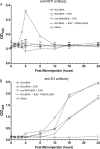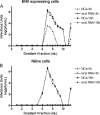Rescue of infectious particles from preassembled alphavirus nucleocapsid cores
- PMID: 21471237
- PMCID: PMC3126313
- DOI: 10.1128/JVI.00039-11
Rescue of infectious particles from preassembled alphavirus nucleocapsid cores
Abstract
Alphaviruses are small, spherical, enveloped, positive-sense, single-stranded, RNA viruses responsible for considerable human and animal disease. Using microinjection of preassembled cores as a tool, a system has been established to study the assembly and budding process of Sindbis virus, the type member of the alphaviruses. We demonstrate the release of infectious virus-like particles from cells expressing Sindbis virus envelope glycoproteins following microinjection of Sindbis virus nucleocapsids purified from the cytoplasm of infected cells. Furthermore, it is shown that nucleocapsids assembled in vitro mimic those isolated in the cytoplasm of infected cells with respect to their ability to be incorporated into enveloped virions following microinjection. This system allows for the study of the alphavirus budding process independent of an authentic infection and provides a platform to study viral and host requirements for budding.
Figures





Similar articles
-
Imaging the alphavirus exit pathway.J Virol. 2014 Jun;88(12):6922-33. doi: 10.1128/JVI.00592-14. Epub 2014 Apr 2. J Virol. 2014. PMID: 24696489 Free PMC article.
-
Imaging of the alphavirus capsid protein during virus replication.J Virol. 2013 Sep;87(17):9579-89. doi: 10.1128/JVI.01299-13. Epub 2013 Jun 19. J Virol. 2013. PMID: 23785213 Free PMC article.
-
The Alphavirus E2 Membrane-Proximal Domain Impacts Capsid Interaction and Glycoprotein Lattice Formation.J Virol. 2019 Feb 5;93(4):e01881-18. doi: 10.1128/JVI.01881-18. Print 2019 Feb 15. J Virol. 2019. PMID: 30463969 Free PMC article.
-
Budding of alphaviruses.Virus Res. 2004 Dec;106(2):103-16. doi: 10.1016/j.virusres.2004.08.008. Virus Res. 2004. PMID: 15567491 Review.
-
A structural and functional perspective of alphavirus replication and assembly.Future Microbiol. 2009 Sep;4(7):837-56. doi: 10.2217/fmb.09.59. Future Microbiol. 2009. PMID: 19722838 Free PMC article. Review.
Cited by
-
Alphavirus Nucleocapsid Packaging and Assembly.Viruses. 2018 Mar 20;10(3):138. doi: 10.3390/v10030138. Viruses. 2018. PMID: 29558394 Free PMC article. Review.
-
Spatial and Temporal Analysis of Alphavirus Replication and Assembly in Mammalian and Mosquito Cells.mBio. 2017 Feb 14;8(1):e02294-16. doi: 10.1128/mBio.02294-16. mBio. 2017. PMID: 28196962 Free PMC article.
-
Self-Assembly of an Alphavirus Core-like Particle Is Distinguished by Strong Intersubunit Association Energy and Structural Defects.ACS Nano. 2015 Sep 22;9(9):8898-906. doi: 10.1021/acsnano.5b02632. Epub 2015 Aug 21. ACS Nano. 2015. PMID: 26275088 Free PMC article.
-
Single-step antibody-based affinity cryo-electron microscopy for imaging and structural analysis of macromolecular assemblies.J Struct Biol. 2014 Jul;187(1):1-9. doi: 10.1016/j.jsb.2014.04.006. Epub 2014 Apr 26. J Struct Biol. 2014. PMID: 24780590 Free PMC article.
-
Identification of a critical role for ZIKV capsid α3 in virus assembly and its genetic interaction with M protein.PLoS Negl Trop Dis. 2024 Jan 2;18(1):e0011873. doi: 10.1371/journal.pntd.0011873. eCollection 2024 Jan. PLoS Negl Trop Dis. 2024. PMID: 38166143 Free PMC article.
References
-
- Cheng F., Mukhopadhyay S. 18 February 2011. Generating enveloped virus-like particles with in vitro assembled cores. Virology doi:10.1016/j.virol.2011.02.001 - DOI - PubMed
-
- Garoff H., Sjoberg M., Cheng R. H. 2004. Budding of alphaviruses. Virus Res. 106:103–116 - PubMed
Publication types
MeSH terms
Substances
Grants and funding
LinkOut - more resources
Full Text Sources

